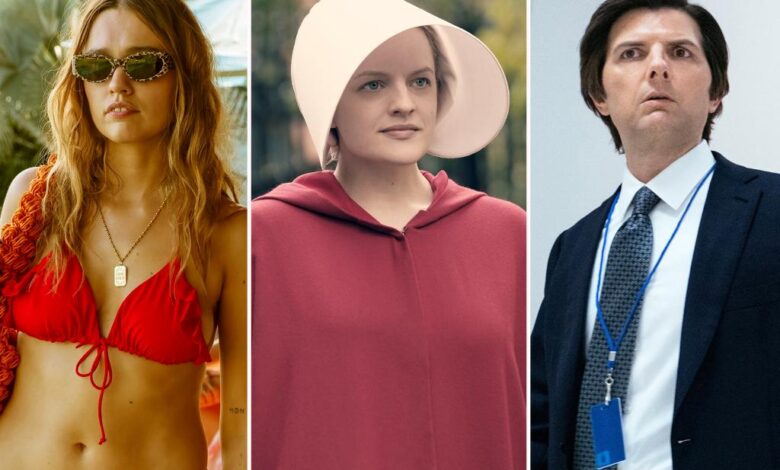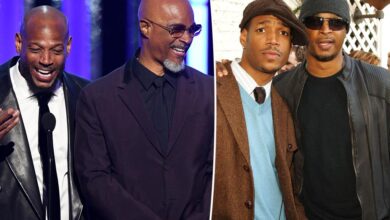When brand collabs go wrong


It’s off brand.
Every so often, a TV show or movie has a brand-tie in that misses the point.
For instance, the hit AppleTV+ show “Severance” is essentially about how work is hell…but the show’s official podcast is filled with ads for work-related platforms.
The iconic red cloaks on “The Handmaid’s Tale” are used to oppress women in that story – so although designer Christian Siriano is collaborating with Hulu to “reclaim” the look, using the outfits on the catwalk (as part of his Fall/Winter 2025 Collection) seems flippant enough to make any fan of the show say, “Yikes.”
“I think sometimes when brands get it wrong – the desire to be associated with a thing that has this following is understandable,” Zoe Kessler, the Executive Creative Director at Johannes Leonardo, told The Post.
She added, “Getting it right is harder, because it takes a bit more thoughtfulness and strategy to show up in a way that’s more specific.”
Another infamous misfire was when CoverGirl did a “Hunger Games” makeup collection.
In the context of that story, the people wearing makeup were Capitol citizens – who gleefully watched kids fight to the death. Katniss Everdeen (Jennifer Lawrence) also got makeup put on her unwillingly, as she was paraded around by her oppressive government before being forced to fight fellow teens.
So, at the time, a makeup collection as a tie-in got slammed as glib and tone-deaf.
In branding misfires like that, Kessler explained, “What they’re doing is borrowing the equity, but not building on it,” which leads to the type of “surface level” tie-in that rings false to audiences.
Because “The Hunger Games” had a specific underlying theme, she said a brand tie-in should have asked, “How can we build on that, instead of just responding to it in a shallow way, so that there’s significance for consumers?”
Magda Tomaszewski, the head of brand management at Gus, told The Post that when brands do tie-ins to TV shows, “they need to show up with intention and meaning. But most importantly, a deep understanding of the audience.”
She explained, “I think when a brand is partnering with a TV show or any kind of entertainment IP, it’s not just about aligning with the story – it’s recognizing how the audience connects emotionally with that story, and then thinking about what is that strong creative strategy that ensures that the brand adds to that connection rather than distracting from it.”
Without considering that audience perspective, she said, “even a well-meaning partnership can feel off-key.”
When branding tie-ins go awry, she said that speaks towards “maybe not really digging into some of the nuances and tonalities of the TV shows or the audience.”
But, not all seemingly odd brand tie-ins are misfires.
For instance, The Four Seasons announced a global brand partnership with HBO for “The White Lotus,” since the hit show often uses the resort as a filming location.
That might seem like an instance of missing the point – because although the show depicts exotic vacations, the characters’ trips always end with a death.
“I actually think it works well for them,” said Tomaszewski.
“I think if anything, it gets [the resort] more bookings and more visits,” she went on. “I know I myself went to visit the Four Season in Maui, because I am a fan of the TV show.”
Despite the murder in the show’s plot, she said, “I think that partnership feels quite organic, and makes a lot of sense.”
Kessler agreed, adding that despite the murder element of the plot, “I still walk away from ‘The White Lotus,’ thinking, ‘wow, that resort is so beautiful!’”
“If anything, if I’m at the Four Seasons, it would be interesting for them to do a kind of murder mystery tie-in as a stunt at one of the hotels. It wouldn’t steer me away if I was working on that brand. I think it’s an interesting hotel tie-in.”
There have also been instances when brands get angry with how they’re depicted in a show.
For instance, Duke University put out a statement admonishing “The White Lotus” for having a scene where Timothy (Jason Isaacs) sported their logo on a t-shirt while holding a gun to his head.
“I get the initial reaction, but when you zoom out, the association actually feels more positive than negative — especially if Duke wants to be seen as a place that cultivates successful, wealthy alumni,” said Tomaszewski.
“By speaking out, they’ve unintentionally spotlighted something that would’ve likely flown under the radar.”
And on the “Sex and the City” spinoff “And Just Like That,” Peleton wasn’t too happy after the show implied that the brand was loosely involved in Mr. Big’s (Chris Noth) death.
But, other brands like Coffee Mate – which had a “White Lotus” pina colada creamer tie-in – adjusted quickly after the show’s Season 3 finale nearly used that beverage in an aborted murder-suicide plot.
The brand hadn’t known about that plot line, and they acknowledged it with a playful statement: “Well, this is awkward.”
Tomaszewski called that, “a great example of a brand leaning into the moment with a wink, showing they understand the cultural context they’re playing in, and staying true to their brand.”
She added, “At the end of the day, it’s a scripted show made to entertain. And for brands, that’s an invitation to step into that world and explore creative, thoughtful ways to expand on it.”
Kessler cited the “Barbie” movie as an example of a movie that did a “phenomenal job” with their brand partnerships. The Margot Robbie film had a dizzying array of tie-in brands, including Pinkberry frozen yogurt, fashion brands such as Pac Sun, Nyx makeup, Funboy pool floats, and more.
“We as humans see ads all the time every day. And we have a really high bullsh-t meter for it, now. Consumers know exactly when something is an ad,” she explained.
“And so, if they’re consuming premium content like the shows that you’ve been mentioning, they’re hyper aware of when it steps away from that and into Ad World. I would encourage brands and creatives to come up with ways where that seam between brand and creative sort of disappears.”




